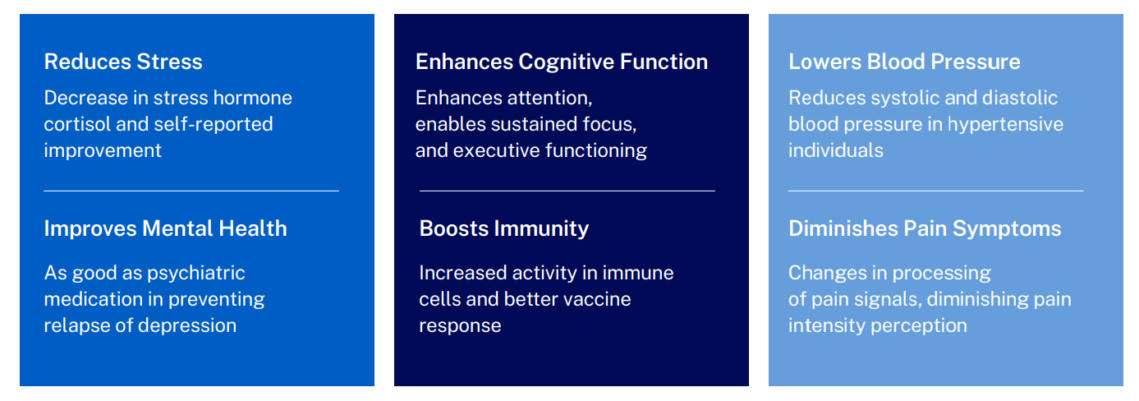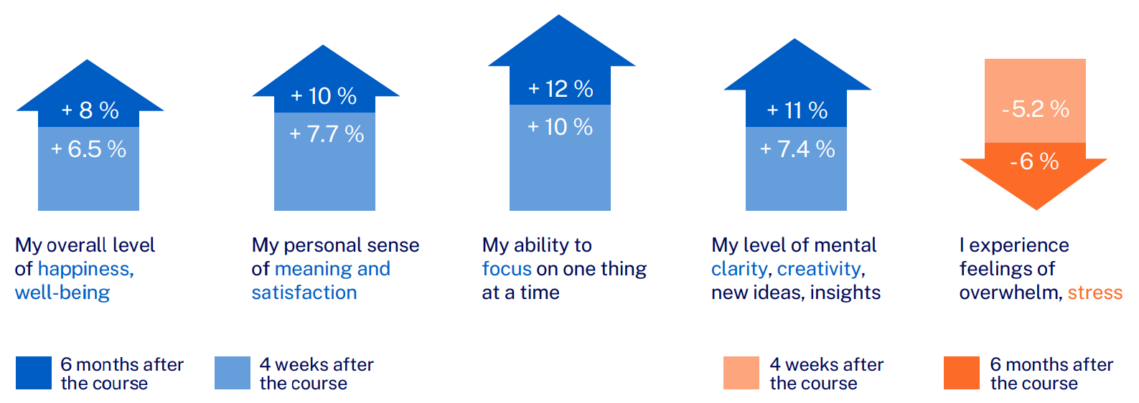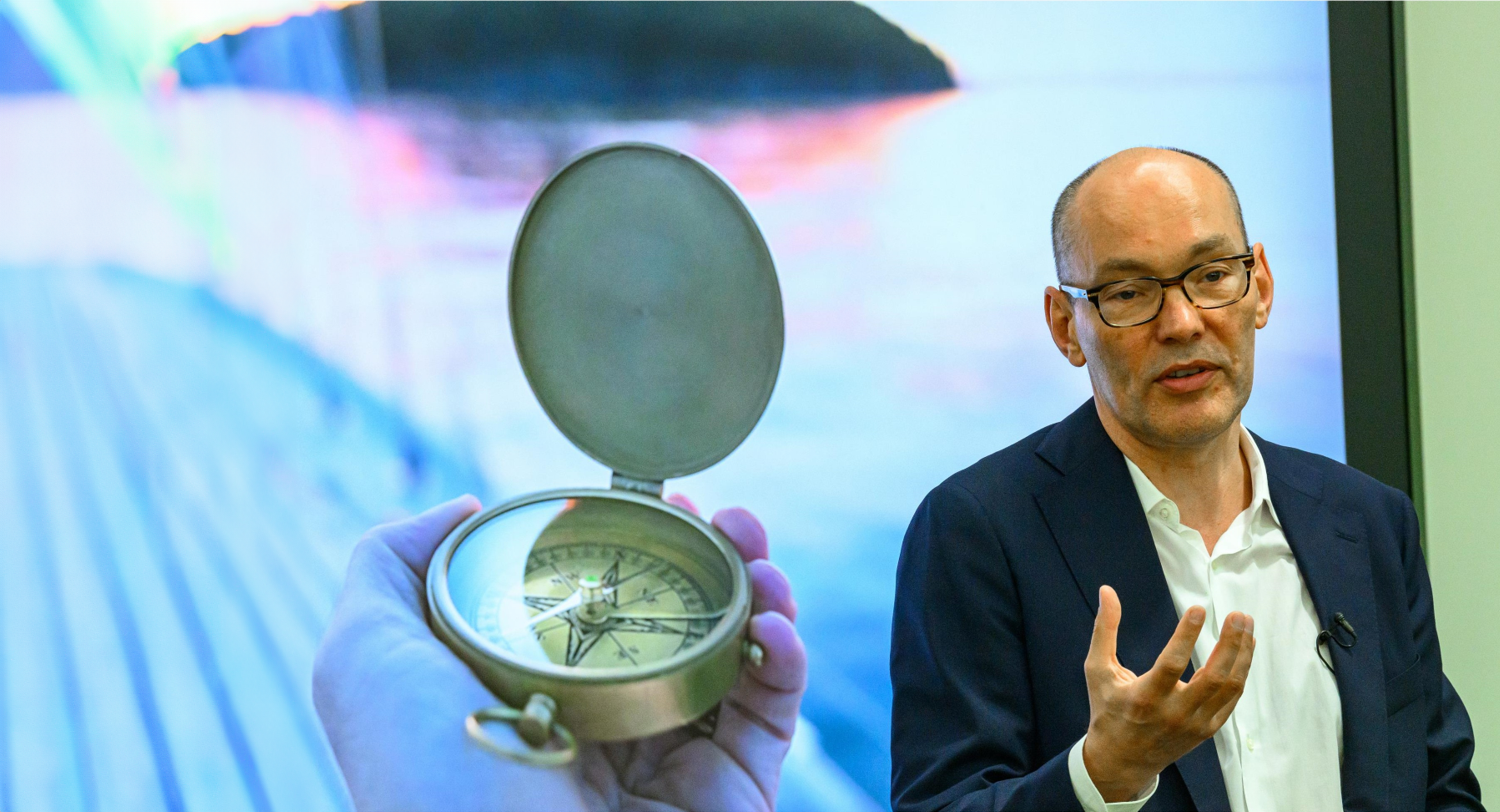At a glance
- Over a 10-year period, SAP delivery executive Peter Bostelmann transformed a grassroots mindfulness movement into a formally recognized Learning and Development (L&D) program at SAP.
- Peter developed a business case for the mindfulness program step by step.
- While canvassing the support of senior leaders, he was also diligent in setting up a data collection system to show the program’s positive impact on both employees and the organization.
- To help manage costs and create a multiplier effect, he developed in-house teachers to spread the program quickly and to sustain mindfulness at SAP.
In the late 2000s, Peter Bostelmann, a delivery executive at SAP in California, turned to mindfulness meditation during a difficult period. By 2012 he wanted the wider SAP organization to also benefit from the positive effects mindfulness had brought him – such as increased self-awareness, improved focus, better work-life balance and an enhanced ability to manage stressful situations.
Peter began by talking openly about his experiences with mindfulness and discovered a few like-minded practitioners in Europe. Noticing that organizations like Google in California had introduced successful mindfulness programs, he decided to test SAP’s readiness for formal training.
The broader issue
It is scarcely news that organizations in the 21st century operate in an increasingly complex environment – a trend that has only accelerated due to the Covid-19 pandemic, supply chain disruptions resulting in shortages and inflation, and the outbreak of several international armed conflicts. In addition, most people are connected – or chained – to ever-present smartphones, work emails, social media and a 24/7 news cycle. Both leaders and employees are experiencing more stress, anxiety and depression.
In response, organizations have been investing in employee well-being, with mindfulness programs and support playing a pivotal role. Peter defines mindfulness as “the self-regulation of attention with an attitude of curiosity, openness and acceptance.” It involves developing self-awareness, managing one’s internal states, impulses and resources, and practicing beneficial mental habits such as cultivating realistic optimism.
While its roots are based in ancient Asian philosophies, the spread of mindfulness in the West began in the latter half of the 20th century when Jon Kabat-Zinn founded the Mindfulness-Based Stress Reduction Clinic at the University of Massachusetts Medical School. The secular, evidence-based program he developed was a significant step toward introducing mindfulness to global organizations such as Monsanto, General Mills, Target, Verizon and SAP.
The practice of mindfulness has been proven to offer various positive benefits for individuals (see Figure 1).

From grassroots to global mindfulness at SAP
Tending the shoots
By the late 2000s Peter had been with the company for over a decade. He began practicing mindfulness privately (“in the closet,” as he referred to it) after witnessing its positive impact on his partner. To navigate a particularly challenging period, he deepened his practice, including attending 10-day mindfulness retreats.
Peter was keen to bring the transformation that he had experienced to others at SAP. When he discovered that there were a few pockets of other mindfulness practitioners based in Germany, Peter leveraged his trips between California and the company’s headquarters in Baden Württemberg to ask if they would be interested in attending a company-sponsored mindfulness program. The most frequent response was along the lines of: “Mindfulness-based training for emotional intelligence and for personal mental strength and resilience sounds fascinating and I would do it. But I am not sure the company is ready.”
This only convinced Peter that SAP was ready for a mindfulness program. He decided the most effective way to gain visibility and support would be to use an existing, externally created and delivered program that had an impeccable reputation. He chose the Search Inside Yourself (SIY) program created by Google engineer Chade-Meng Tan, neuroscientist Philippe Goldin and mindfulness teacher Marc Lesser.
SIY helped people develop the skills of mindfulness, empathy, compassion and overall emotional intelligence, with the aim of creating the conditions for individuals and collectives to thrive. SIY had been so successful at Google that other organizations wanted to offer it to their own employees. Google therefore set up the non-profit Search Inside Yourself Leadership Institute (SIYLI) to disseminate the program more widely.
In late 2012 Peter met with SAP’s chief medical officer and global head of health and well-being management, Natalie Lotzmann. After a robust discussion, Natalie agreed that SIY would benefit employees and that Peter, with his own deep background in business and mindfulness, was the right person to bring it to SAP. She also challenged him to define a strategy to scale the program globally and offered him a temporary role as “fellow” in her department while he set things up.
In parallel, Peter decided to test his theory. At that time, California was the epicenter for organizational mindfulness in the western world, with other global companies – Cisco, Genentech and Google – providing mindfulness courses for employees. In May 2013 he organized an event with the country’s mindfulness “superstars” – Chade-Meng Tan, Rich Fernandez, Marc Lesser and Meg Levy – at SAP’s Palo Alto office. It was packed, with 500 employees present. Peter took advantage of the opportunity to ask attendees if they would be interested in finding sponsorship from their own management to attend the two pilots he was organizing for the second half of 2013. He was able to recruit 25 managers and 25 employees to the pilots.
Deepening the roots
In 2014 Peter was appointed director of the SAP Global Mindfulness Practice (GMP), with the objective of organizing mindfulness-based programs and fostering the community of mindfulness practitioners globally at SAP. His task was to transform the grassroots movement into a global initiative. In addition, after the first successful pilots, Peter found his first sponsor in Germany. Wolfgang Fassnacht, the director of human resources in Germany, was also a long-time mindfulness practitioner. He was convinced SIY would be positive for employees in his organization and added SIY as part of the Learning and Development (L&D) portfolio in Germany. This was a key step in scaling it throughout SAP.
“I heard about SIY by chance and then I was able to help get the budget to run it. Peter came then several times to Germany and started with delivering trainings. They were very well received and very soon SIY was the most requested training in my portfolio.”
– Wolfgang Fassnacht, Director of HR, Germany
News about the impact of SIY spread throughout the organization and by the end of the year the waiting list was 1,500 strong. To further scale the desired culture of mindfulness, Peter needed to find a way to create a multiplier effect and to deliver SIY in a cost-effective way. To that end, he created a pool of in-house trainers to educate subsequent cohorts. The first teacher training took place in 2015, after which SAP had 10 internal teachers. Participants were vetted before being selected and followed a rigorous six-month certification process.
SIY went from strength to strength, with the waiting list peaking at 9,000 employees in 2016. As a result, the GMP began integrating elements of SIY into its internal L&D programs and developed its own portfolio of modules for organizational mindfulness. The GMP mandate was then expanded to include delivering organizational mindfulness training to the company’s clients.
Did it work?
In the space of a decade Peter grew a grassroots mindfulness movement into a global initiative. From the beginning, he gathered data to build a business case for organizational mindfulness. The GMP surveyed 650 participants at both four weeks and six months post-program and found improved well-being, happiness, concentration, creativity and less stress in the work context (see Figure 2).

In addition, the program contributed to an increase in the Employee Engagement Index and a reduction in sick leave. These values impacted the company’s business results. SAP conducted annual Employee Engagement and Business Health Culture Index surveys. Every percentage point increase in the Employee Engagement Index added €50 to €60 million to the company’s operating profit. A percentage point increase in its Business Health Index raised profits by €85 to €95 million. Taking these results together, Peter calculated a return on investment of 200%.
Takeaways
- Improving performance: The complex and changing world impacts both employees and organizations. Mindfulness is a proven method to help employees reduce stress, as well as improve attention, focus and performance. This leads to better organizational performance.
- Gaining support: It is possible to bring mindfulness to an organization by building a business case to help secure the support of senior leaders.
- Training and development: Peter chose SIY, an externally developed program with a stellar reputation, to bring mindfulness to SAP. To offer the experience to as many employees as possible, he developed a group of in-house teachers. This helped control costs, while creating a multiplier effect.
This article is based on IMD cases IMD-7-2489 and IMD-7-2521, available from The Case Centre at www.thecasecentre.org.










